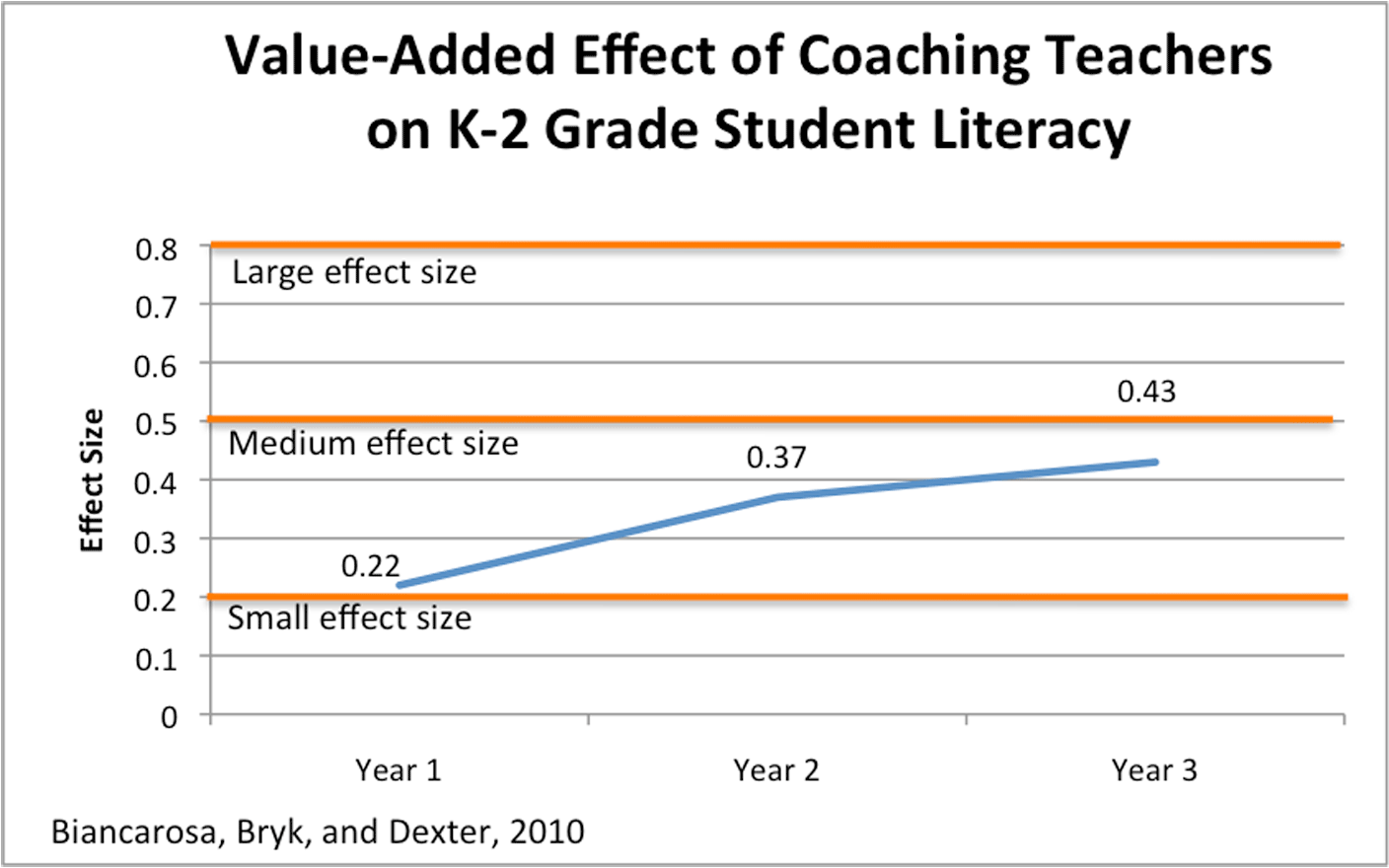Does the use of coaching as a professional development strategy improve student performance?
Why is this question important? Research provides evidence that teachers improve student performance (Sanders & Rivers, 1996; Mendro, Jordon, Gomez, Anderson, & Bembry, 1998; Rowan, Correnti, & Miller, 2002). Logically, the way to maximize the impact of teachers on students is to use the most effective pedagogical techniques in teacher preparation as well as ongoing professional development programs. Following up the impact of better prepared teachers with studies that use rigorous research methods is important.
See further discussion below.

Source(s): Assessing the Value-Added Effects of Literary Collaborative Professional Development on Student Learning, 2010
Result(s): The Biancarosa, Bryk, and Dexter study found that, in terms of program effects, the average value added during the first year of implementation represented a 16% increase in learning as compared with the average baseline growth rate. During the second year of implementation, the estimated value added was a 28% increase in productivity over baseline growth. The third year yielded a 32% increase in productivity over baseline. These value-added effects convert into standard effect sizes of 0.22 in year 1, 0.37 in year 2, and 0.43 in year 3.
The study also found that children who entered with lower literacy tended to learn at a faster rate than those who enter with higher literacy.
Implication(s): The study provides evidence that coaching can be an effective teacher training technique that results in improved student performance. It builds on the work of Joyce and Showers (2002), which found that coaching in staff development was a critical factor in increasing the likelihood of newly learned skills actually being used in the classroom. Nonetheless, the knowledge base supporting the use of coaching as an effective tool for improving teacher and student performance remains limited, and further research needs to be conducted to verify the results of the Biancarosa et al. study.
A question that the study does not answer but remains critical is this: When taken to scale, is coaching a cost-effective training strategy? Unless coaching can be implemented using existing staff and funding, its impact and benefits may be limited.
Author(s): Gina Biancarosa, Anthony S. Bryk, and Emily R. Dexter
Publisher(s): The Elementary School Journal
Study Description: The study examined the value-added effect of literacy coaching, provided to teachers as a professional development intervention, on the literacy learning of kindergarten through second-grade students. It was based on a 4-year longitudinal field trial taken from 27,427 observations of 8,576 students in 17 schools located in eight states across the eastern United States. During the course of the study, the students attended 287 teachers’ classrooms.
The authors analyzed the effectiveness of professional development in the Literacy Collaborative (LC) program, which relies heavily on one-to-one literacy coaching as a means of improving student literacy learning. The program is built around the hypothesis that teachers need training in particular procedures as well as opportunities to analyze their teaching using feedback from an expert.
Coaches for the study were teachers selected from their schools to lead the improvement effort. The coaches received graduate-level training emphasizing coaching for 1 year while also teaching children. During the year 1 baseline period, data was collected for each school and classroom. After a year of training, the coaches reduced their teaching hours and spent approximately half of their time coaching teachers in their assigned schools. The study’s second through fourth years consisted of implementation of LC professional development training in classrooms.
The results reported were for the effects on student literacy learning over 3 years of implementation compared with the baseline year, using an accelerated multicohort longitudinal quasi-experimental design that permitted a value-added modeling of the effects of coaching on student learning.
Definition(s):
Accelerated multicohort, longitudinal quasi-experimental design: Research design used to collect data over time for multiple groups of persons that are defined by demographics such as age. The purpose is to study age-outcome for the members of the cohorts during a study of short duration to determine the existence of common trends.
Coaching: The professional development interaction in which a trained coach works one-on-one with a teacher in the classroom observing the teacher, modeling effective use of skills, and providing feedback to increase the effectiveness of the teacher’s instructional skills.
Literacy collaborative: A comprehensive school reform designed to improve elementary children’s reading, writing, and language skills through school-based coaching.
Quasi-experimental design: Research designs that are more rigorous than pre-experimental studies in that they employ a means to compare groups. They fall short, however on one very important aspect of the experiment: randomization. When subjects are chosen for groups based on convenience rather than randomization, the reason for inclusion in the experiment will confuse our ability to assign cause to the results of the study
Value-added modeling: Statistical analyses providing quantitative performance measures that can be used to develop, monitor, and evaluate schools and other aspects of the education system.
Citation:
Biancarosa, G., Bryk, A. S., & Dexter, E. R. (2010). Assessing the value-added effects of literary collaborative professional development on student learning. The Elementary School Journal, 111(1), 7–34.
Mendro, R., Jordan, H., Gomez, E., Anderson, M., & Bembry, K. (1998). An application of multiple linear regression in determining longitudinal teacher effectiveness. Dallas, TX: Dallas Public Schools.
Rowan, B., Correnti, R., & Miller, R. (2002). What large-scale research tells us about teacher effects on student achievement: Insights from the prospects study of elementary schools. Consortium for Policy Research in Education. Retrieved February 9, 2011 from [PDF] upenn.edu
Sanders, W. L., & Rivers, J. C. (1996). Cumulative and residual effects of teachers on future student academic achievement. University of Tennessee Value-Added Research and Assessment Center. Retrieved September 18, 2010 from https://citeseerx.ist.psu.edu/viewdoc/download?doi=10.1.1.474.3738&rep=rep1&type=pdf
